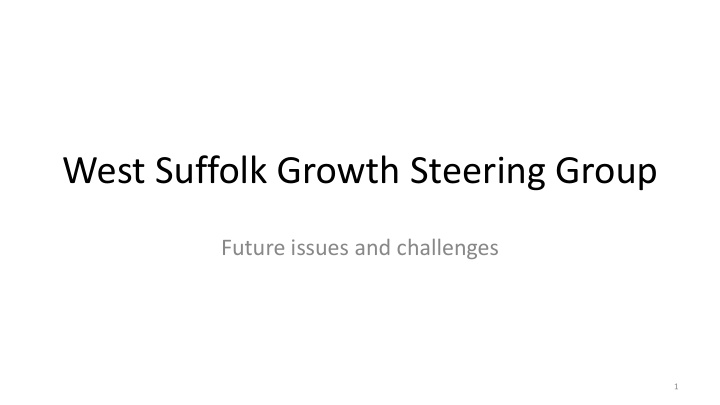



West Suffolk Growth Steering Group Future issues and challenges 1
“Good” Growth • Different Focus – not just about Gross Value Added (GVA) • Value of policies, interventions and initiatives on local “Place” and rural communities • Outcomes: • Right jobs? • Wealth distribution? • Skills? • Work/life balance, • Health? • Housing? • Vibrant town centres?
Innovation Population and futures change Key challenges Housing Skills and and choice and wages affordability opportunities Health and Cambridge care Wave 3
What we already know? Population Changes: • By 2037, 5 dependent people (3 older people and 2 children) for every 5 people of working age. • 2014-2039: 63% increase in the population aged 65+ in West Suffolk, compared to a 2.2% increase in the population aged 20-64 (ONS sub-national population projections 2014). • By 2037 Suffolk Demographic changes will increase health and care costs substantially by over 50% over 75s and 120% over 85s (health and care per head costs from Kasteridis et al, 2014) • At current admission rates and lengths of stay: by 2037 two additional hospitals would be needed to serve the needs of the Suffolk population
What do we already know? Skills and wages We need a skilled workforce to support and increasing dependent population However: • West Suffolk lags below England averages both for achieving a good level of development at age 5 (reception year) & achieving A* - C in GCSEs (inc English and Maths) (2015-16) • The proportion of working age people qualified to NVQ4+ in West Suffolk (32.8% (FHDC) and 33.1% (SEBC) also lags behind the Great Britain average (38.2%) • These skills issues are reflected in the lower than average pay levels in West Suffolk : Forest Heath St Edmundsbury Suffolk East Great Britain Earnings [by place of residence] Gross weekly pay 2016 £ 455.10 £ 536.30 £ 519.10 £ 569.40 £ 541.00
What do we already know? Housing choices and affordability • 2016 median house price to income ratios are worse for West Suffolk (9(SEBC) & 7.8 (FHDC) than for rest of Suffolk (7.7) & England (7.7) • The lower quartile house price to lower quartile income ratios are worse than the median ratios in FHDC (8.6), SEBC (9.4) and Suffolk (8). This is in contrast to the national picture, where the lower quartile ratios (7.2) are better than the median ratios (7.7). • The lower quartile rent in FHDC is the same amount as the national Median rent (£7,800). Almost half of residents’ income is spent on rent compared to national 30 %. (Source: 2016 ONS)
Innovation and futures West Suffolk also needs to consider where it can get ahead, and take opportunities & turning it’s challenges into opportunities , for example: - Artificial intelligence - Medical science - New models of health and care - Social entrepreneurialism - Further innovations in digital technologies - Climate change adaptation - New patterns of work / home / community life - Supporting wellbeing (mental and physical) 7
Starting the discussion : where should our focus be in West Suffolk? • Prevention – building the solutions in to growth (e.g. healthy communities, with social as well as physical infrastructure) • Continued focus on education and skills • Housing delivery – variety and affordability • Balancing the economy – how could larger companies / higher skills work complement West Suffolk’s strong SME sector? • Strengthening rural economy • Inclusive growth – sharing the opportunities and the benefits 8
Responding to the challenges and opportunities Key question for the group: • Based on what we know • the location of west Suffolk and our existing places; • the people who live here, or want to live here, their history, culture and aspirations; • the natural resources we have; and • the challenges and opportunities we face, What are your initial ideas about the ‘right kind of growth’ for West Suffolk? 9
Recommend
More recommend